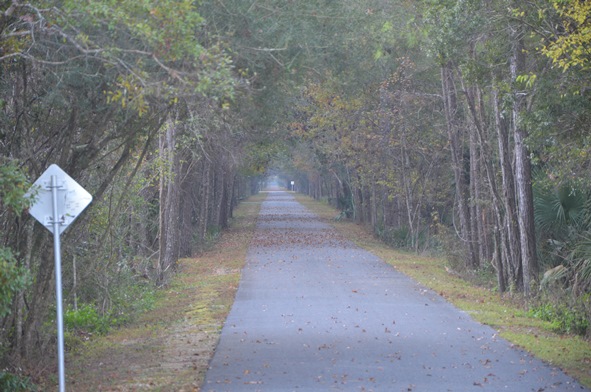
by Les Harrison | Dec 8, 2017

A great walk or ride is close at hand on this trail which once supported a critical 19th century transportation link.
The typical image of a state park is that of a place where visitors enter through a front gate and enjoy the wonders of nature or some historic structure. The Tallahassee-St. Marks Historic Railroad State Trail, which is run by The Florida Division of Recreation and Parks, is truly an exception to the typical model.
While many parks have trails, this one runs 20.5 miles from Tallahassee to the coastal community of St. Marks. This area is the first rail-trail in the Florida’s system of greenways and trails to be paved providing a scenic experience for running, walking, bicycling and skating.
Additionally, horseback riding occurs on the adjacent unpaved trail. Because of its outstanding qualities, this state trail has been selected as a National Recreation Trail.
The origins of this 21st century recreational site date back to before Florida was a state. The Tallahassee Railroad Company was approved in 1835 by the territorial legislative council and received the first federal land grant to a railroad for construction of the line.
Cotton and other commodities moved from the Tallahassee region to the port of St. Marks for shipment to the north east U.S. and to Great Brittan. Raw cotton was the major generator of foreign exchange during the antebellum years, so this railroad was a critical economic link in the area’s development.
Fast forward to 1983, that is when the Seaboard Coastline filed the papers to abandon the line and end service. After 147 years, the longest-operating railroad in Florida was deemed economically unfeasible to operate.
It was not out of service for long. In 1984 the corridor was purchased by the Florida Department of Transportation, and the rest is history.
Visitors can access the trail in multiple locations along the way. Parking areas are provided at many locations along the trail with mileage markers make available distance information and the trail corridor is lined with trees providing plenty of shade.
Restroom facilities are placed at intervals along the trail. There are picnic pavilions and a playground at the Wakulla Station Trailhead.
The trail is open from 8:00 a.m. until sundown, 365 days a year and there is no use fee required. Donations which aid with the promotion and upkeep are accepted.
For more information on the St. Marks Trail, contact the park office at (850) 487-7989 or Tallahassee-St. Marks Historic Railroad State Trail.
While the historic structures are gone, it is a great way to enjoy nature’s wonders close to the coast.
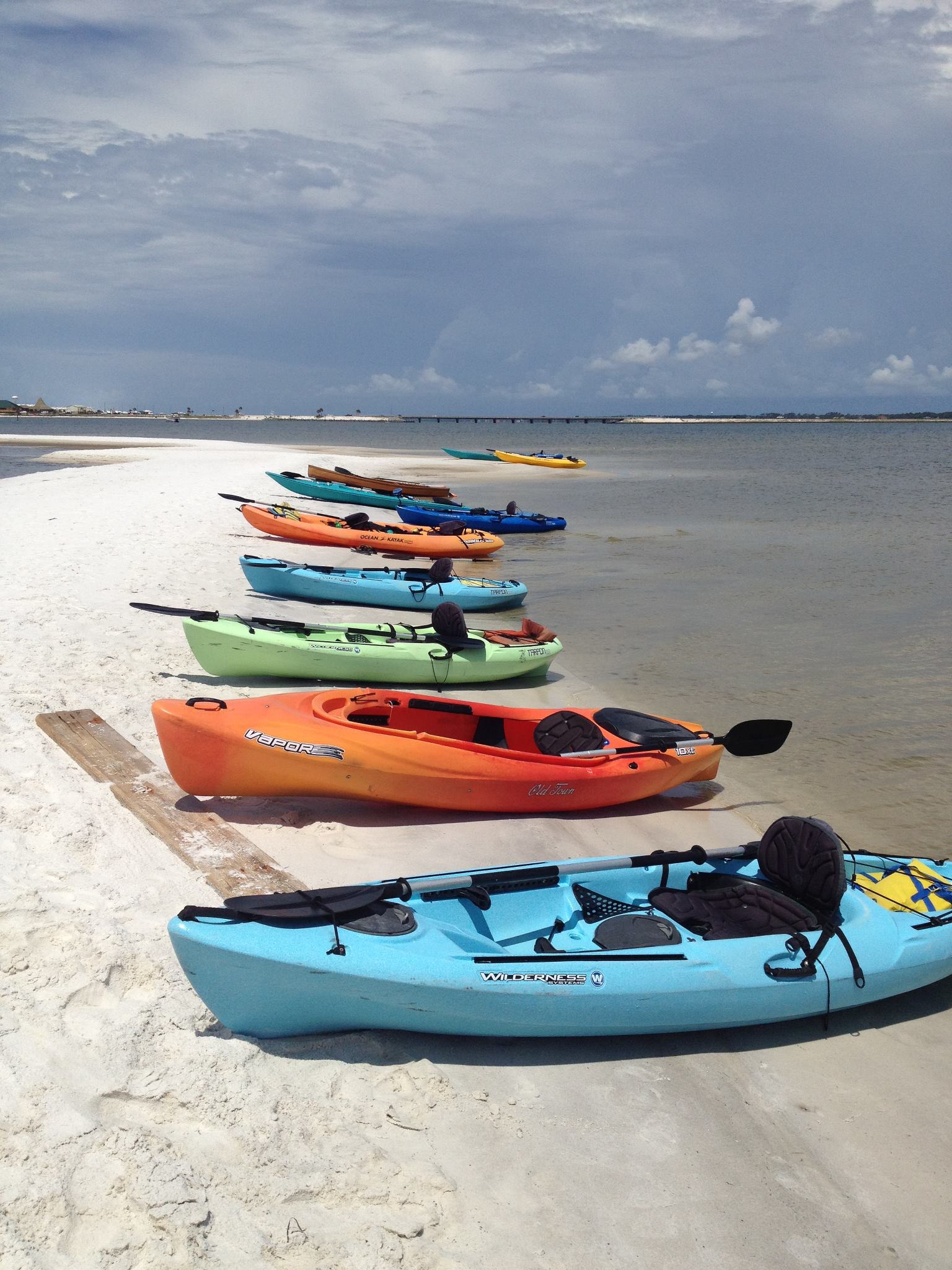
by Carrie Stevenson | Jun 17, 2017
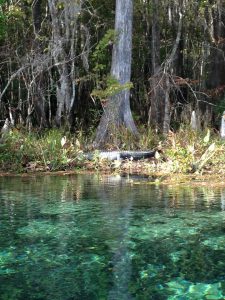
Wakulla Springs is home to some of the best wildlife watching in all of northwest Florida. It’s not unusual to see manatees, alligators, and dozens of species of birds in one boat trip. Photo credit: Carrie Stevenson
What do you imagine when the word “ecotourism” comes to mind? I know I usually daydream about a trip my husband I took to Costa Rica several years ago, surrounded by lush tropical rainforests as we ziplined through the canopy. I might also think about visiting a National Park, following a neatly maintained trail and stopping at signs placed at just the right spot so visitors can read and understand the special features of the place. Ecotourism, done right, brings a visitor to a unique place, tells its story, and immerses the visitor in the sights and sounds in a way that treads lightly on the location. I always know I’ve been on a good ecotour when I’m tired, happy, and have learned or seen something new.
A colleague with The Conservation Fund has stated that sustainable tourism includes: “Authentic experiences that are unique and specialized to the place (its culture, heritage, and natural resources), emphasizes quality over quantity, focuses on distinctive destinations, unspoiled landscapes, and historic buildings, and differs from mass-market tourism by favoring locally-owned businesses, thereby increasing circulation of money in the local economy.” The truly wonderful thing about ecotourism is that local touch; it exists solely because of the place, so it cannot be outsourced. The best storytellers about those places are usually the people who have lived there for many years, so by its very nature, ecotourism provides jobs for local residents.
Northwest Florida has hundreds of unique locations for visitors and locals to explore…we have centuries-old forts, clear-blue springs, endless rivers and creeks to paddle, trails on the coast and up our modest hills. We have caves and underground caverns, waterfalls, pitcher plant prairies, fishing, wildlife watching, and reefs for snorkeling and SCUBA diving. While millions come here for our quartz-sand beaches, other options that highlight our natural ecosystems deserve more attention and notoriety.
A few years ago, several Extension Agents received funding for a project called Naturally EscaRosa. The idea behind that project was to help promote and create businesses that sustainably used our agricultural and natural resources. The website (www.naturallyescarosa.com) has a list of over 100 businesses and locations where locals and out-of-town visitors can explore the less well-traveled areas of Escambia and Santa Rosa County. As you move east down the coast, Walton Outdoors, the local Visit Florida affiliates, and other privately managed media groups have done similar work, providing a showcase for these treasures in our midst.
This summer, try one of the local ecotourism or agritourism venues near you! Moreover, when your friends and family visit from out of town, encourage them to do the same. We cannot have a successful economy without a healthy ecosystem, and supporting these local and regional businesses is good for both.
For more information on sustainable ecotourism, visit the Society for Ethical Ecotourism (SEE), and for information on starting or visiting an agritourism business, try Visit Florida Farms. And as always, reach out to your local County Extension agents, and we will be more than happy to point you in the right direction to discover to places to explore with your family.
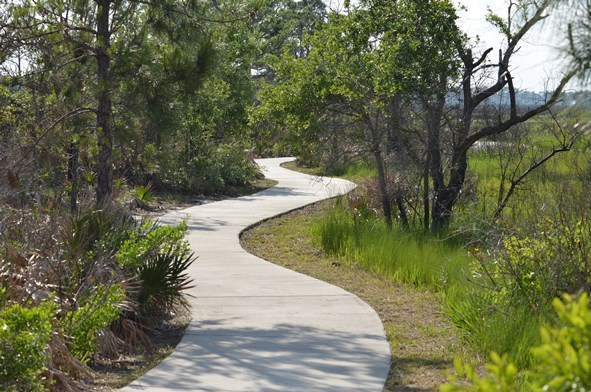
by Les Harrison | Jan 8, 2017
Some of the most picturesque and scenic natural areas along north Florida’s Gulf Coast are found in Bald Point State Park. The 4,065 acre park is located on Alligator Point, where Ochlockonee Bay meets Apalachee Bay.
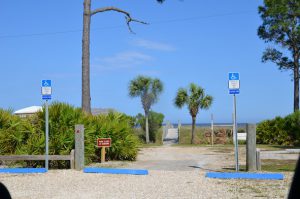
Easy access to water activities at Bald Point State Park.
Photo: Les Harrison
Bald Point State Park offers a variety of land and water activities. Coastal marshes, pine flatwoods, and oak thickets foster a diversity of biological communities which make the park a popular destination for birding and wildlife viewing.
These include shorebirds along the beach, warblers in the maritime oak hammocks, wading birds, and birds of prey in and around the marsh areas. The boardwalk and observation deck overlook the marsh near the beach.
During autumn bald eagles and other migrating raptors, along with monarch butterflies are frequently viewed heading south to a warmer winter.
Bald Point offers access to two Apalachee Bay beaches for water sports and leisure activities, and these facilities include a fishing dock and picnic pavilions at Sunrise beach, North End beach and Maritime Hammock beach. Grills and restrooms are also available, but pets are prohibited on the beach.
Pre-Columbian pottery helped archaeologists identify the park’s oldest site, placing the earliest human activity 4,000 years ago. These early inhabitants hunted, fished, collected clams and oysters, and lived in relatively permanent settlements provided by the abundant resources of the coast and forests.
In the mid-1800s and late 1900s, fishermen established seineyards at Bald Point. These usually primitive campsites included racks to hang, dry and repair nets. Evidence of the 19th to 20th century turpentine industry is visible on larger pine trees cut with obvious scars.
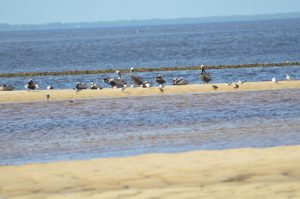
Bald Point is an excellent location for both wildlife viewing and birding.
Photo: Les Harrison
Among the varieties of saltwater fish found in the brackish tidal waterway are redfish, trout, flounder and mackerel.
Today’s visitors may fish on the bridge over tidal Chaires Creek off of Range Road, and in Tucker Lake, by canoe or kayak. Sea trout, red fish, flounder and sheepshead are common catches, and this is an excellent area to cast net for mullet or to catch blue crabs.
Bald Point State Park is open 8:00 a.m. to sunset daily, with a charge $4.00 per car with up to eight people, or $2.00 per pedestrian or bicycle
More information is available at the Florida State Park site.
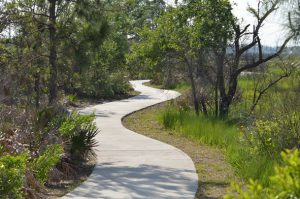
There are numerous trails where the visitor and explore Florida.
Photo: Les Harrison.
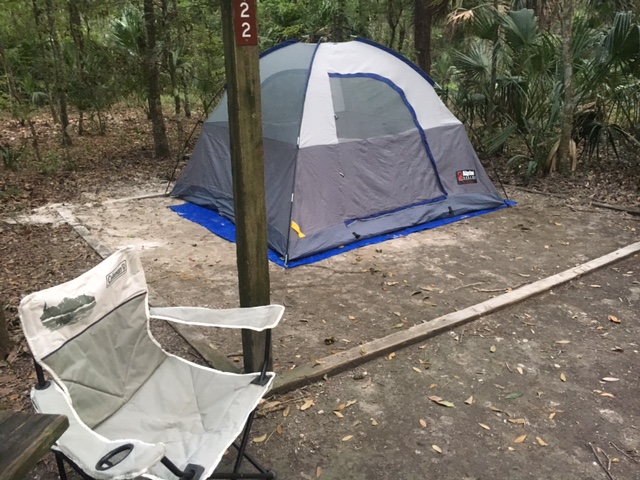
by Rick O'Connor | Sep 16, 2016
This past week I was camping at a state park near Gainesville. Working on a variety of computer related items while sitting in my chair, I was acutely attuned to the sounds of life around me. A small “pat-pat-pat” could be heard in the leaf litter around the tent. Curious as to what was making the sound, I moved the leaves until numerous small frogs showed themselves – and immediately settled on my tent. The wind rustling through the trees, the distinct “kee kee kee” of the red shouldered hawk, and the sounds of numerous woodland song birds filled the senses and all caused me to pause my work and listen to life.
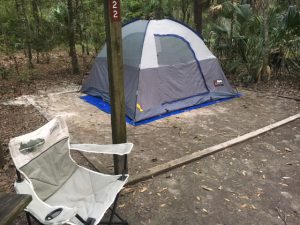
Camping is a great way to clear the mind, think through problems, and experience the natural world.
Photo: RIck O’Connor
The evenings were no different… the loud rustling of digging armadillos, the distinct calls of at least two types of owls, and the howling of coyotes could be heard every night. Then one evening…nothing… it all stopped. I heard no owls, coyotes, or frogs. The woods had become completely silent. Funny how you notice silence as much as you do the “calls of the wild”.
The following morning the skies were different. They were not dark but you could sense rain was in the area. I moved into the tent in time for the rain to begin…a light rain, but rain none the less. And it rained all day… and most of the night. I was dry within my tent – continued to work on my computer – but was aware of the extent of the rain and of the silence around me. It was not until later that evening that I heard there was a tropical system on the Atlantic coast. The woods had become silent the afternoon before…did they know it was coming?
Camping does this… it reconnects us to the natural world. We can experience Florida the way our ancestors would have. To listen to the animal sounds, sense the changes in the weather, and explore. Yes, explore. You can only sit at the campsite for so long. Most campgrounds provide hiking trails and swimming areas where you can not only explore nature but get much needed exercise. Some campgrounds provide elevated observation towers with benches where you can sit, listen, look, and let the hub-bub of typical daily life escape you for a while. Honestly… here I get some of my best ideas for work. I think clearer and can prioritize a hectic schedule of “to-do’s”. I recommend bringing a small notebook to jot down ideas as they come. It is very relaxing and productive at the same time.
If you have kids… perfect! There are fewer “wild areas” within neighborhoods for kids to explore their natural world. Many youth today have not experienced finding hermit crabs or frogs. Camping is a great way for them to do this. I understand that some are nervous about different forms of wildlife while camping (snakes) but honestly, I rarely see them. They have learned to stay clear of open areas – I have bigger problems with squirrels and ants. Do not let that stop you from enjoying Florida.
There are several state parks with camp grounds in the Florida Panhandle; Torreya State Park even has a couple of yurts! You may need to reserve a site. There are campgrounds scattered in the Apalachicola National Forest, which are less visited. If you are in the Escambia / Santa Rosa area – you can visit Naturally EscaRosa.com to find camping options in that area.
So let’s chill a bit… and go camping!
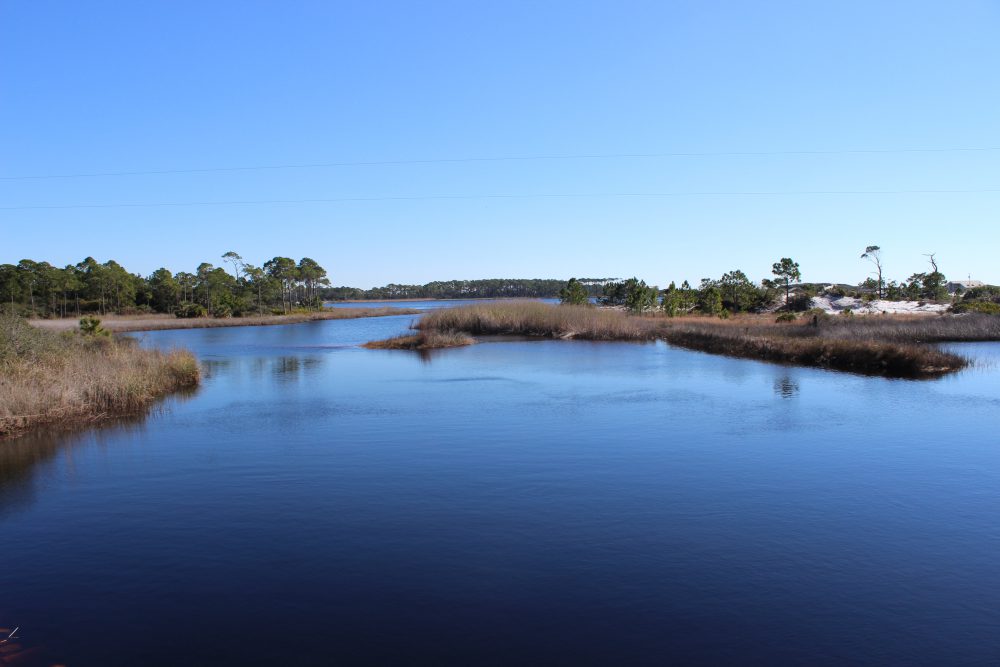
by Rick O'Connor | Jun 17, 2016
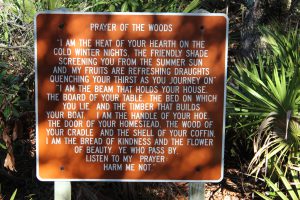
The “Prayer of the Woods” is an attitude that many in this part of the panhandle try to live.
Photos: Molly O’Connor
30A in south Walton County is a special place.
Undiscovered for years, then developed… but developed more sustainably than most coastal panhandle communities – this area has now become a go-to destination for many in the southeastern U.S. Grayton Beach, Seaside, Water Color, and others were developed with idea of walkable-biking community and allowing as much nature to remain as possible. Many subdivisions use native plants for their landscaping. It is a neat area to explore.
My base camp for this part of our ICW tour was Topsail State Park. Though there are numerous other locations to camp, they were all full… the 30A Song Writers Festival was going on at the time. The first thing I noticed was a bike trail that extends much of 30A itself. There were locations along the way where visitors can rent bicycles and it is a great way to take in the scenery… and there is scenery. Some of the more majestic dunes I have seen anywhere along the panhandle are found here. Dunes in Pensacola use to look like these but storms have taken their toll – somehow the dunes of 30A were spared.
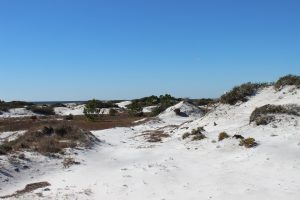
The spectacular dunes of south Walton County.
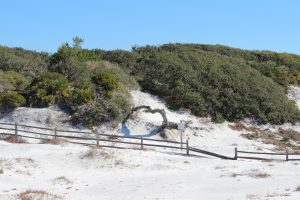
The wind sculpted plants of the tertiary dunes.
You cannot talk about the dunes without talking about the dune lakes. Scattered across much of the panhandle the highest concentration, and least impacted, of these lakes are found here in Walton County. These freshwater lakes are separated from the high saline Gulf of Mexico by a field of dunes. There are channels that connect them but these are sometimes closed by moving sand. When open, these channels allow the brown tannic waters of the lakes to spill into the Gulf – a weird sight which trigger thoughts of pollution. You can see evidence of high tides entering the lakes with the presence of cordgrass and needlerush (classic salt marsh plants) and species of marine fish such as stingray and redfish. There is access to some of the dune lakes via the state parks. Here there are trails along the shore and through the dunes, and kayaks to rent. The gulf is not but a few feet away – this is a great place to bring snorkel gear or binoculars for birding.
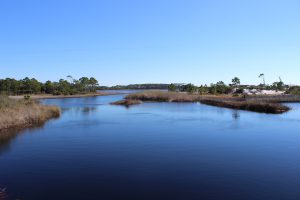
One of the many “jewels of south Walton” – the dune lakes.
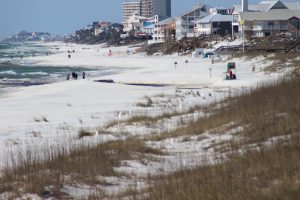
In the distance you can see the brown-tannic water of a dune lake entering the Gulf of Mexico.
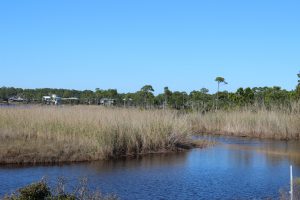
Black Needlerush is one of the species of marsh grasses that live in brackish conditions.
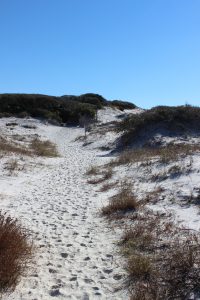
Dune trail at Grayton Beach State Park
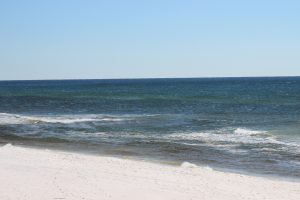
The Gulf of Mexico in south Walton County.
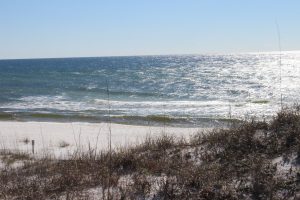
Another view of the Gulf of Mexico.
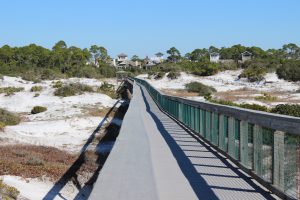
The boardwalk of Deer Lake State Park off of Highway 30-A. you can see the tracks of several types of mammals who pass under at night.
There are additional state park and state forest trail heads along 30A to explore. Accommodations are hard to come by during peak season so you will have to plan ahead – but a few days here is worth it.
If visiting the Escambia / Santa Rosa area be sure to check out the Naturally EscaRosa website and download the app to find great outdoor adventures in the western panhandle.





















